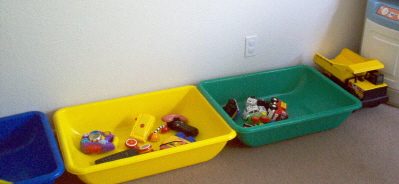If you refuse to discipline your children, it proves you don't love them;
if you love your children, you will be prompt to discipline them.
|
When most people think of discipline, punishment comes to mind. I would like to say that discipline is both positive and negative; both praise and punishment.
The gives the meaning of "discipline":
1. training to improve strength or self-control
2. the act of punishing
3. the trait of being well behaved
4. a system of rules of conduct or method of practice
5. a branch of knowledge
6. punish in order to gain control or enforce obedience
7. train by instruction and practice; esp. to teach self-control
|
The first definition says "training". This is the true discipline of toddlers--Training. I find when the children first come to my child care or when they first start to crawl, that's when I spend most of the time training the child. I train them by reinforcing good behavior and redirecting when the child does unwanted behavior.
Here is what works for me:
 Training: For example, I do not want children climbing on the table. When a child does this, I will say, "no climbing on the table," remove the child off the table and get the child involved in something else. When the child is playing at the table nicely, I will reward this behavior with praise such as, "I like how you are coloring at the table. Tables are for coloring on, not climbing." A hug will usually follow.
Training: For example, I do not want children climbing on the table. When a child does this, I will say, "no climbing on the table," remove the child off the table and get the child involved in something else. When the child is playing at the table nicely, I will reward this behavior with praise such as, "I like how you are coloring at the table. Tables are for coloring on, not climbing." A hug will usually follow.
 Reward Chart: From about 18 months, each child has a Reward Chart. When I "catch" the child doing good, I let him/her put a sitcker on the chart. Each time a child helps pick up toys, helps another child (shows empathy), puts his/her cup on a table, takes dishes to the sink, or helps out in any way, I give a sticker. When the chart is full, the child can choose a prize from the Prize Box (a shoe box with balloons, stickers, 8-pack crayons, toothbrushes, string of plastic beads, small toys, etc.--Party favors work well here). This is rewarding and putting focus on good behavior. Here's printable Charts (scroll down to "Colourful blank charts").
Reward Chart: From about 18 months, each child has a Reward Chart. When I "catch" the child doing good, I let him/her put a sitcker on the chart. Each time a child helps pick up toys, helps another child (shows empathy), puts his/her cup on a table, takes dishes to the sink, or helps out in any way, I give a sticker. When the chart is full, the child can choose a prize from the Prize Box (a shoe box with balloons, stickers, 8-pack crayons, toothbrushes, string of plastic beads, small toys, etc.--Party favors work well here). This is rewarding and putting focus on good behavior. Here's printable Charts (scroll down to "Colourful blank charts").
 Re-directing: This works well with the youngest children. When a child does an unwanted behavior, I say, "no," and move him/her to another area where the children are allowed to play. When the children get a little older and they are doing something undesirable such as climbing on the furniture, I say, "You can't climb on the furniture, but you can climb on the slide."
Re-directing: This works well with the youngest children. When a child does an unwanted behavior, I say, "no," and move him/her to another area where the children are allowed to play. When the children get a little older and they are doing something undesirable such as climbing on the furniture, I say, "You can't climb on the furniture, but you can climb on the slide."
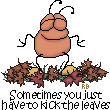 Provide "Yes's" : It seems I am saying NO to the toddlers constantly. If found if I have climbers, I provide 'okay to climb on' toys. If the toddlers are always in the kitchen cupboards, I provide an 'okay cupboard' to explore. If I have throwers, I provide soft balls or socks to throw. I still train the kids not to climb on, get into, or throw other things, but I give them something they CAN do.
Provide "Yes's" : It seems I am saying NO to the toddlers constantly. If found if I have climbers, I provide 'okay to climb on' toys. If the toddlers are always in the kitchen cupboards, I provide an 'okay cupboard' to explore. If I have throwers, I provide soft balls or socks to throw. I still train the kids not to climb on, get into, or throw other things, but I give them something they CAN do.
| Example: I had a boy who always climbed on the table and shelves. He wanted to push furniture around and moved chairs a lot. He threw toys constantly and basically was in trouble a lot. After spending months saying "no, NO, NO!!!" I decided to say "yes" to as much as I could. I brought in a small slide structure the children could climb on, I took out the problem climbing shelf and replaced it with a shelf that he could climb into. I took most of the small, hard toys out and provided only soft balls. I also provided big trucks he could push around. The child's behavior turned around! He learned to climb where it was okay and throw the soft things. It was way less stressful for us both! Take a peek at our new setup here. |
 Time-Out: When the child is near 2-years-old I begin using the Time-Out chair. It sits in a corner of our playroom away from toys, but in sight. If a behavior is repeated and/or if I tell a child not to do something and they go ahead and do it anyway, a Time-Out is given. I sit the child down in the chair and the time begins when the child is quiet. I set my microwave timer for one minute per age of the child (a 2-year-old sits for 2 minutes). When the timer goes off, the child may resume play as usual. Take a look at my Time-Out Chair.
Time-Out: When the child is near 2-years-old I begin using the Time-Out chair. It sits in a corner of our playroom away from toys, but in sight. If a behavior is repeated and/or if I tell a child not to do something and they go ahead and do it anyway, a Time-Out is given. I sit the child down in the chair and the time begins when the child is quiet. I set my microwave timer for one minute per age of the child (a 2-year-old sits for 2 minutes). When the timer goes off, the child may resume play as usual. Take a look at my Time-Out Chair.
 Toy Time-Out: I have a box labeled "Toy Time-Out" and put it up high. When two children are fighting over one toy or a child can't behave with a certain toy, I put the toy in the box for the rest of the day.
Toy Time-Out: I have a box labeled "Toy Time-Out" and put it up high. When two children are fighting over one toy or a child can't behave with a certain toy, I put the toy in the box for the rest of the day.
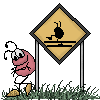 Take Turns: It's too hard for toddlers to share. When one child wants a toy that another child is playing with, instead of saying the word "Share" I say, "It's X's turn right now and next it will be your turn." The word "Share" implies giving up the object, so I've stopped using it.
Take Turns: It's too hard for toddlers to share. When one child wants a toy that another child is playing with, instead of saying the word "Share" I say, "It's X's turn right now and next it will be your turn." The word "Share" implies giving up the object, so I've stopped using it.
 Have A Plan: I find when I don't have a plan, neither do the toddlers. They start doing whatever they please and sometimes that isn't desired behavior. A simple routine can calm things down. Do the same thing in order everyday (not necessarily at the same times). First we have TV time, then free-play, next is snack, then diaper changing time. If you stick to the order, the kids will know what comes next and not get so anxious or wild. Also, if you have a few planned activities throughout the day, it helps. Block out some of your time to do a craft or build with Duplos with the children. If you need some ideas check out my Toddler Themes, Monthly Themes, Plan B Curriculum, and Other Daycare Curriculum. Also, have a plan when the children act out. Make your reaction to the unwanted behavior immediately and consistently.
Have A Plan: I find when I don't have a plan, neither do the toddlers. They start doing whatever they please and sometimes that isn't desired behavior. A simple routine can calm things down. Do the same thing in order everyday (not necessarily at the same times). First we have TV time, then free-play, next is snack, then diaper changing time. If you stick to the order, the kids will know what comes next and not get so anxious or wild. Also, if you have a few planned activities throughout the day, it helps. Block out some of your time to do a craft or build with Duplos with the children. If you need some ideas check out my Toddler Themes, Monthly Themes, Plan B Curriculum, and Other Daycare Curriculum. Also, have a plan when the children act out. Make your reaction to the unwanted behavior immediately and consistently.
 Love the Unlovely: When a child constantly acts out, sometimes it's hard to love him/her. Sometimes there is personality conflict between provider and child or sometimes there's a problem with a parent that may be taken out on the child. I'm not suggesting that any of this is done consciously, but when a child acts out he/she wants your attention and it will most always be resolved by making an effort to pay attention to the child and "catch" him/her being good, rewarding good behavior with praise and making an effort to give positive attention to the child.
Love the Unlovely: When a child constantly acts out, sometimes it's hard to love him/her. Sometimes there is personality conflict between provider and child or sometimes there's a problem with a parent that may be taken out on the child. I'm not suggesting that any of this is done consciously, but when a child acts out he/she wants your attention and it will most always be resolved by making an effort to pay attention to the child and "catch" him/her being good, rewarding good behavior with praise and making an effort to give positive attention to the child.
 Make Drastic Changes: Sometimes the same 'ole way just won't work with some children. In my example above I had to rearrange my whole playroom. It meant taking some things out of the room that made it easier for the other children, but I had to for the safety of all. This is drastic for my "I want everything to be the same way" personality. Once I made the changes it was way less stressful for everyone.
Make Drastic Changes: Sometimes the same 'ole way just won't work with some children. In my example above I had to rearrange my whole playroom. It meant taking some things out of the room that made it easier for the other children, but I had to for the safety of all. This is drastic for my "I want everything to be the same way" personality. Once I made the changes it was way less stressful for everyone.
 Be Consistent: This is the most difficult part of managing toddlers! Sometimes, because I am tired or too busy with something else, or whatever, I overlook behavior that needs attention. This is confusing to the toddlers and then the behavior gets worse! I have to train myself to be consistent in the praise and re-direction of the children. When I step-up and I am consistent, the behavior of all is very good.
Be Consistent: This is the most difficult part of managing toddlers! Sometimes, because I am tired or too busy with something else, or whatever, I overlook behavior that needs attention. This is confusing to the toddlers and then the behavior gets worse! I have to train myself to be consistent in the praise and re-direction of the children. When I step-up and I am consistent, the behavior of all is very good.
 Give Choices: Giving the child choices gives the child power. This works for children who feel like they need to be in control. The choices should be two or more acceptable things like "Do you want to wear your blue or green shirt today?" or "Do you want to play with the blocks or cars?" I often combine this with "You can't throw toys, so do you want to drive the cars or build with the blocks?" This helps with a picky eater, too: "Would you like carrots or green beans with your lunch today?"
Give Choices: Giving the child choices gives the child power. This works for children who feel like they need to be in control. The choices should be two or more acceptable things like "Do you want to wear your blue or green shirt today?" or "Do you want to play with the blocks or cars?" I often combine this with "You can't throw toys, so do you want to drive the cars or build with the blocks?" This helps with a picky eater, too: "Would you like carrots or green beans with your lunch today?"
The choices don't always have to be positive. An example of a negative choice would be "Do you want to sit in Time-Out or would you like to play nicely with your friends?" Be careful about doing this too often. It should be used sparingly before things get out of hand.
 Acknowledge the Child's Feelings. Children want to be heard as much as adults do. Those that don't talk very well (toddlers are famous for this) need to know that they are understood. When a child is frustrated, I've found it helps to repeat what the child is trying to say, "You wanted to play with that." "You didn't like that she took your toy." "You wanted to be first in line." Just knowing that the adult understands many times defuses the frustration. You can empathize with the child and let them know what will happen next. "I know you wanted a turn, your turn is coming next. I'll wait with you."
Acknowledge the Child's Feelings. Children want to be heard as much as adults do. Those that don't talk very well (toddlers are famous for this) need to know that they are understood. When a child is frustrated, I've found it helps to repeat what the child is trying to say, "You wanted to play with that." "You didn't like that she took your toy." "You wanted to be first in line." Just knowing that the adult understands many times defuses the frustration. You can empathize with the child and let them know what will happen next. "I know you wanted a turn, your turn is coming next. I'll wait with you."
| Some great resources: |
|
|  |
|
|
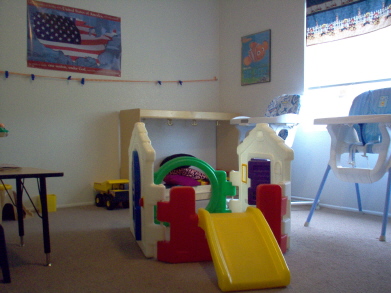 |
Here is the "okay to climb on" play structure. This seems just the right size.
The shelf in the background isn't as functional as my regular Toy Shelf, but it is working as a no-climb shelf.
Also in the background you can see the large dump truck the children love to push around. And on the bottom shelf, our Sensory Pillows that are great for moving around the room. |
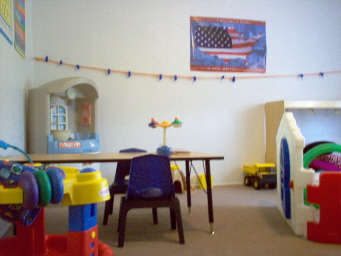 |
In the background of this photo, you can barely see under the table, a toy mountain that the Matchbox cars drive over, under, etc.
Also, in the background is the toy kitchen. The toddlers love to open and close the doors more than anything! |

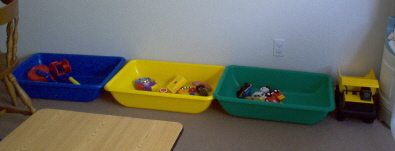
I found a great alternate solution from the one above! I got these sand/water tubs from Discount School Supply. Instead of using them for sand and water, I put some toys in them. This really keeps the two-year-old focused. Of course the kids sit in them, but I don't mind. Clean up is much easier, too. It seems less is more!
